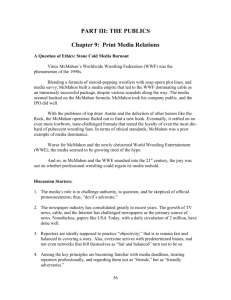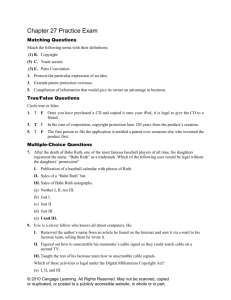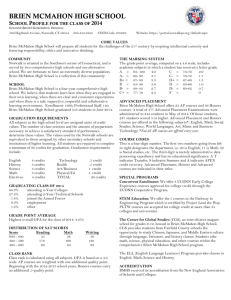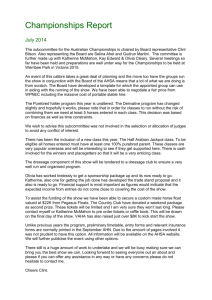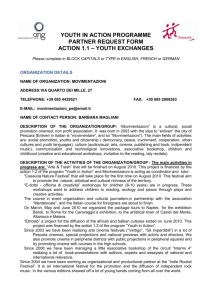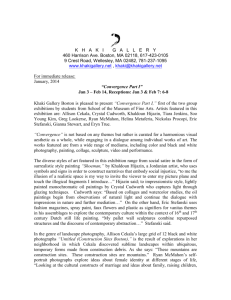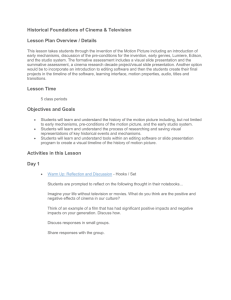Moving Images, Mirrors and Indefinitely Unfolding Objects
advertisement
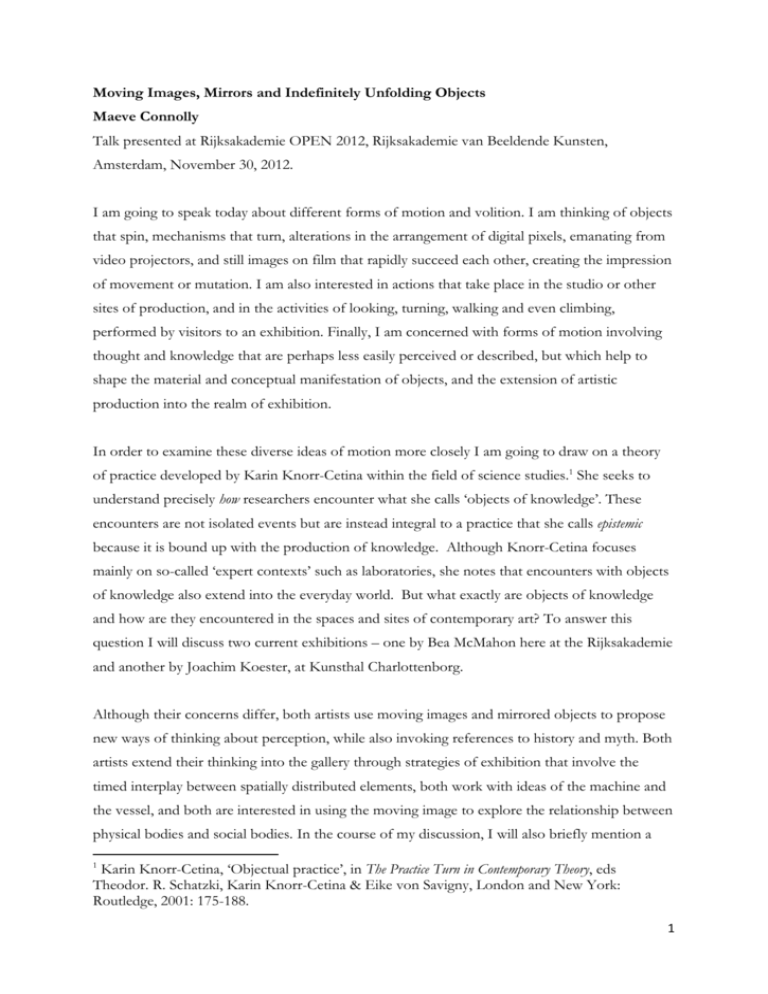
Moving Images, Mirrors and Indefinitely Unfolding Objects Maeve Connolly Talk presented at Rijksakademie OPEN 2012, Rijksakademie van Beeldende Kunsten, Amsterdam, November 30, 2012. I am going to speak today about different forms of motion and volition. I am thinking of objects that spin, mechanisms that turn, alterations in the arrangement of digital pixels, emanating from video projectors, and still images on film that rapidly succeed each other, creating the impression of movement or mutation. I am also interested in actions that take place in the studio or other sites of production, and in the activities of looking, turning, walking and even climbing, performed by visitors to an exhibition. Finally, I am concerned with forms of motion involving thought and knowledge that are perhaps less easily perceived or described, but which help to shape the material and conceptual manifestation of objects, and the extension of artistic production into the realm of exhibition. In order to examine these diverse ideas of motion more closely I am going to draw on a theory of practice developed by Karin Knorr-Cetina within the field of science studies.1 She seeks to understand precisely how researchers encounter what she calls ‘objects of knowledge’. These encounters are not isolated events but are instead integral to a practice that she calls epistemic because it is bound up with the production of knowledge. Although Knorr-Cetina focuses mainly on so-called ‘expert contexts’ such as laboratories, she notes that encounters with objects of knowledge also extend into the everyday world. But what exactly are objects of knowledge and how are they encountered in the spaces and sites of contemporary art? To answer this question I will discuss two current exhibitions – one by Bea McMahon here at the Rijksakademie and another by Joachim Koester, at Kunsthal Charlottenborg. Although their concerns differ, both artists use moving images and mirrored objects to propose new ways of thinking about perception, while also invoking references to history and myth. Both artists extend their thinking into the gallery through strategies of exhibition that involve the timed interplay between spatially distributed elements, both work with ideas of the machine and the vessel, and both are interested in using the moving image to explore the relationship between physical bodies and social bodies. In the course of my discussion, I will also briefly mention a 1 Karin Knorr-Cetina, ‘Objectual practice’, in The Practice Turn in Contemporary Theory, eds Theodor. R. Schatzki, Karin Knorr-Cetina & Eike von Savigny, London and New York: Routledge, 2001: 175-188. 1 work by Clemens von Wedemeyer, which shares some of the same concerns as it uses a mirrored object to explore the cultural, architectural and social properties of cinema.2 I hope some of you have had the opportunity to see McMahon’s work Volume, which is installed here in one of the project spaces. My first experience of this work was in a slightly different configuration, presented as part of her exhibition ‘Root’ at Temple Bar Gallery and Studios in Dublin. That presentation also included two ceramic sculptures Skin Spectrum – Indigos and Reddish Yellows and Skin Spectrum – Greens and Browns. Bea McMahon, Skin Spectrum – Indigos and Reddish Yellows and Skin Spectrum – Greens and Browns. (2012) Ceramic 46cm x 40 cm x 10cm; installation Temple Bar Gallery and Studios, Dublin. Photo credit: Ronan McCrea As will be apparent if you have seen the installation here, Volume is a ‘moving image work’ in multiple senses; it consists of a three channel HD synced video with sound and two kinetic sculptures. One of the sculptures is a three-sided rotating mirrored object with shiny surfaces that have been sprayed with milk to reduce reflection. It is one of two projection surfaces used in Volume – the other is a conventional screen. Importantly, the rotating mirrored object is not 2 It might also be interesting expand this discussion to include works such as Black Mirror by Charlie Brooker, an anthology style drama realised for television. 2 simply a screen as it also appears as a kind of prop within the filmed action, although at times it is barely visible because of its reflective surfaces. Much of the action in Volume takes place on or near a body of still water – yet another reflective surface. At one point in the narrative, a young woman seated in small rowing boat is gently unbalanced by another passenger. Bea McMahon, Still from Volume (2012) – Part 4. to transfer across Toppling from the vessel into the water, she does not resurface. This event occurs in a sequence with the title ‘To transfer across’, a phrase that might simply describe the mundane action of the boat or suggest a more final crossing. This action is in fact an allusion to the story of Hippasus, an ancient Greek mathematician who was allegedly thrown from a boat. He was drowned because his discovery of the square root of two (an irrational number) challenged the Pythagorean theory of divine correspondence between numbers and the universe. McMahon is interested in this belief system, partly because it is not bound by a strict division between mathematics and mysticism. In fact, as noted by the philosopher Bertrand Russell, Pythagoras was both a mathematician and a mythical figure, credited with miracles and magical powers.3 McMahon’s Dublin exhibition Root took its title partly from the story of Hippasus and partly from the branching structure commonly deployed to visualise the theory of evolution, so it references two different situations of potential conflict between knowledge (or belief) systems. 3 See Bertrand Russell, A History of Western Philosophy, first published in 1945, 50. 3 But rather than setting out to illustrate or explain these beliefs, McMahon instead presents interactions between characters and objects in which metaphorical, mythological and metaphysical frameworks for interpretation seem to overlap. She also draws attention to the etymology of the word ‘metaphor’, which comes from the Greek meta (over, across) and pherein (to carry, bear). This etymology is explored in her exhibition through the production of ceramic amphoras, which are on display here for the first time. Combining volume and surface, amphoras are containers that often bear narrative decoration and, as ceramic objects, they are also the solid form of a material that was itself once liquid. Bea McMahon, ceramic amphoras, 2012 As is probably apparent, McMahon is drawn toward slippages between states of being, and between ideas and objects. So in Volume, the body entering the water operates simultaneously as a passage to another realm, a reference to the dissolution of concepts of divinity, and a transition between two states of being. McMahon describes this work is ‘an examination of the light interchange at the surface of things’, which involves conceiving of ‘the site of the boundary of a body as a soft crossing or thoughtful crossing’. Her statement refers in part to the bounding properties of skin and water, as surfaces that are permeable and yet capable of reflecting or absorbing light. So water is imagined as a kind of mirror, a surface for boats to move across, a 4 body to be entered, and a boundary that can be used to establish both divisions and connections between people and places. Volume responds to the boundaries between water and land in the Dutch polder landscape of Het Twiske, where it was shot. This landscape is both ‘untouched’ (in the sense that it has been maintained as a polder) and profoundly ‘made’ because its status as land is the result of human labour. Skin – another boundary explored in this work – is obviously not mirror-like. Nonetheless it also reflects light in varied ways. So it too plays a role in the formation or alteration of boundaries between people and objects, and in the imagining of ‘social bodies’ as collectives. McMahon’s works is also attentive to the material properties of other substances – such as film, milk and fired clay. So part one of Volume (‘a loop and a tern’) owes its form to the notion of loop of film twisted to form a Möbius strip. Bea McMahon, Still from Volume (2012) – Part 1. A loop and a tern A bird captured in flight on HD video is visible against the backdrop of a bright blue sky, but suddenly seems to fall into nothingness before reappearing on the left of the screen in horizontally reversed form. Here, rather than using the technique of ‘looping’ to create the illusion of continuous motion, McMahon treats the digital video of the bird in motion as if it were filmic matter capable of being physically twisted. The focus on surfaces becomes even 5 more pronounced in part two (‘Plot’), which seems at first to consist solely of a still image of stony ground overlaid with text, alternating between the words ‘still’ and ‘moving’. But, as evidenced by the intermittent crawling of an insect, this sequence is actually composed of both still and moving images of the ground and so it draws attention to the act of perceiving (or misperceiving) motion. The relation between rock, insect and implied observer in this sequence might also be a reference to the destabilisation of the Pythagorean worldview. This worldview, disrupted by Hippasus, was organised around an idea of the divine but it was also human-centred in relation to the perception of phenomena such as motion and stasis. Once the human-centre vantage point is contested, the world can be conceived differently – for example as a planet orbiting around a much larger sun, on which insects, rocks and humans are always actually ‘moving’. Part three of Volume (‘With Chlorophyll’) deploys much more conventional cinematic narrative techniques, introducing the young female protagonist who will subsequently topple passively from the boat. The camera follows her as she walks purposefully through meadows near the water’s edge, but at other moments the camera moves through the grasses just above ground level, as though depicting the worldview of a much smaller creature. Later in part three, the surface of the image appears to shimmer or distort, as though the action is being reflected in a watery mirror. This almost imperceptible visual distortion coincides with activation of the other projection surface – requiring viewers to reposition themselves in relation to the mirrored object. The images projected onto this surface are long grasses, shot from a low angle. Significantly, however, these grasses were not photographed directly. Instead they are reflections captured in 6 the object’s surface when it was shot on location. As it begins to rotate, both on screen at Het Twiske and in the gallery, the object presents ‘itself’ simultaneously as image, prop and kinetic sculpture. Its material form is also ambiguous because it combines liquid and solid matter. Later on in the synchronized sequence, the mirrored object and the other sculpture (which is green and made of metal) begin to rotate at the same time. First the mirrored screen reflects images of pure colour produced using 35mm slide film and transposed to HD video and then the green object begins to spin as though its purpose is to split (or harvest) these colours. Finally, the colour ‘fields’ give way to a doubled shot of the female protagonist, emanating from two projectors trained upon the rotating mirrored object. She is standing against a white backdrop, holding one of the Skin Spectrum sculptures in front of her face and, as the rotations of the screen gather speed, the combination of motion and doubled 7 image produces an illusion of depth similar to the effect created by holography. So the image seems to slip off the surface and hover in the air, existing without material support. This spinning action might also suggest an attempt to somehow fuse the woman’s body with the pale flesh-coloured sculpture she holds in her hands. To me, the action of the woman on screen holding the object resonates with a phrase that is found in the press release for Root. According to this phrase, McMahon ‘handles readymade conventions and concepts and reworks them’. But what does it actually mean to handle conventions and concepts as though they are material things? At this point, I want to return to the objects of knowledge theorised by Karen Knorr-Cetina, and specifically to a distinction that she makes between epistemic objects and their everyday counterparts: The everyday viewpoint, it would seem, looks at objects from the outside as one would look at tools or goods that are ready to hand or to be traded further. These objects have the character of closed boxes. In contrast, objects of knowledge appear to have the capacity to unfold indefinitely [...]. Since epistemic objects are always in the process of being materially defined, they continually acquire new properties and change the ones they have.4 Here, the term ‘ready to hand’ is used in order to recall Heidegger’s account of the ways in which objects tend to become transparent in use.5 According to Heidegger, the ‘ready-to-hand’ object ‘withdraws, so to speak, into its readiness-to-hand, in order precisely to be genuinely ready-tohand.6 Heidegger’s ideas have been especially important for thinkers such as Graham Harman in understanding how objects (both material and conceptual) have been apprehended within art, philosophy and science. As Harman points out, objects can lose this quality of ready-to-handness for several reasons and the best-known example in Heidegger’s analysis is when a hammer breaks and ‘makes us see it for the first time “as” a hammer’. In much the same way ‘earthquakes remind us of the importance of solid ground, while medical problems call our 4 Knorr-Cetina, 181. Emphasis added. Knorr-Cetina, 178. 6 Heidegger, cited by Graham Harman (with emphasis added) in ‘Heidegger on Objects and Things’, in Making Things Public: Atmospheres of Democracy, edited by Bruno Latour and Peter Weibel, Karlsruhe and Cambridge, Mass.: ZKM and MIT Press, 2005, 268. 5 8 attention to our invisible reliance on healthy bodily parts’.7 Heidegger also allows for exceptions to the ready-to-handness of objects as a consequence of ‘advanced theoretical behaviour’, which puts them ‘openly on display “as” what they are’.8 So if we look more closely at the distinctions offered by Knorr-Cetina, we actually have two different ideas of motion or volition on the part of objects. First we have the everyday ‘withdrawal’ of tools, the earth and the human body, which we only notice where there is a problem. Second, we have objects of knowledge that seem to be continually changing and acquiring new properties.9 I am interested in the idea that while ‘withdrawing’ everyday objects seem to recede or shrink from us, objects of knowledge actually invite a kind of pursuit. In Heidegger’s model, scientific inquiry involves the objectifying of objects through detachment.10 This is very different from the more intimate and physical notion of ‘handling’ conventions and concepts proposed by McMahon’s work, and it is also at odds with Knorr-Cetina’s account, which emphasises desire in place of detachment. Knorr-Cetina makes the point that objects of knowledge are never ‘fully attained’, as themselves. Instead, they are revealed, through observation, inquiry and material definition, as ‘representations or stand-ins for a more basic lack of object’.11 The affective dimension is not incidental here – instead it is integral to epistemic practice, because the epistemic object ‘uniquely matches the “structure of wanting”’ outlined in the Lacanian schema of the ‘mirror stage’. This scheme, as is well known, involves an impulse toward an image of apparent wholeness, which is projected onto others.12 So there seems to be a complex and interdependent relation between objects of knowledge and desire, in which the objects are bound up with ‘wants’ that cannot be entirely fulfilled, helping to motivate the continuation of object-oriented practice.13 I find this account very compelling because it draws attention to the material instantiation of objects of knowledge at certain moments and also to their instability as ‘unfolding structures of absences: as things that continually 7 Harman, 268. Harman, 268. 9 Knorr-Cetina, 181. 10 Knorr-Cetina, 187. 11 Knorr-Cetina, 181. 12 Knorr-Cetina, 185. 13 Knorr-Cetina, 185. 8 9 “explode” and “mutate” into something else’.14 So even if pursued, they remain somehow always out of reach, and are always encountered incompletely. I am interested in the possibility that art practice – particularly practices of exhibition-making involving the interplay between spatial, temporal and material elements – may articulate a sense of this unfolding and pursuit, motivated by desire. McMahon’s work seems especially attuned to the affective dimension of ‘objectual practice’ and to the structure of wanting that is bound up with imagined images of wholeness. It is perhaps for this reason that mirrored and reflective surfaces are so pervasive in her practice, sometimes figuring as a means to explore failures or limits of representation. Bea McMahon, still from [in, the] visible state (2008) Two channel DV projection on milk coated mirrors, 7min 25sec. 14 Knorr-Cetina, 182. Emphasis added. 10 These themes find expression in an installation from 2008, [in, the] visible state, incorporating video projections onto two mirrors coated with buttermilk. This work is replete with material and textual references to reflective surfaces, ranging from close-up shots of the viscous surface of the human eyeball to the story of a Dublin university campus, where a large square that might have served as a space of social gathering (or protest) was instead transformed into a shallow and reflective lake.15 McMahon continues this investigation of visibility in Volume, but also materially and conceptually extends it through the production and display of objects (like the mirrored screen) that have a doubled existence inside and outside the ‘frame’. In this way, the exploration of the surface of things that she enacts in the landscape of Het Twiske is unfolded into the exhibition, transforming the gallery into a space where objects of knowledge are shared. Now I want to turn briefly to other artists working with reflective objects and to mention a work by Clemens von Wedemeyer from 2010 called Sun Cinema. Clemens von Wedemeyer, Sun Cinema, 2010, Sculptural open air cinema (double sided screen construction), film "Light & Space" (HD video, 16:9, 59 min) This is a sculptural open air cinema with a double sided screen construction, permanently installed at the city of Mardin in Turkey. The project also encompasses a moving image work, entitled Light & Space. The film explores Mardin’s ancient history as a site of sun worship, its current use as a location for film production, and some of the social practices of its disparate ethnic and religious communities. 15 For a more detailed discussion see Maeve Connolly, The Place of Artists’ Cinema: Space, Site and Screen, Bristol and Chicago: Intellect Books and University of Chicago Press, 2009, pp. 198-203. 11 Clemens von Wedemeyer, Sun Cinema, 2010, Sculptural open air cinema (double sided screen construction), film "Light & Space" (HD video, Image shows a public screening of Light & Space As you can see Sun Cinema is a functioning movie theatre in the evenings but it is also designed to reflect light and to be visible from distance. Clemens von Wedemeyer, Sun Cinema, 2010, Sculptural open air cinema (double sided screen construction), film "Light & Space" (HD video, 16:9, 59 min) So the screen is an object with a dual orientation, directing attention toward the physical setting of Mardin by day, but also offering another way of experiencing the city, which is attuned to the role of imagination and projection in practices of social gathering. Perhaps more significantly, for 12 the purposes of my discussion, the film Light & Space emphasises von Wedemeyer’s presence as a cultural outsider – a visitor who is always moving and continually presented with new, and divergent, ways of knowing the city. In many respects it is an account of Mardin as a object of knowledge, and it includes several compelling sequences that suggest a pursuit of meaning that remains always slightly out of reach. The final artist I want to discuss is Joachim Koester, who shares with von Wedemeyer an interest in using quasi-anthropological strategies to explore and test the boundaries between truth and fiction. I am specifically interested in Koester’s current exhibition, entitled ‘If One Thing Moves, Everything Moves’, which incorporates works realised between 2005 and 2012. The first work encountered is The Magic Mirror of John Dee, a photograph of a highly polished obsidian (or volcanic glass) stone. Like the Greek philosopher Pythagoras, John Dee was both a mathematician and a mystic. His mirror or ‘shew-stone’, which was brought to Europe from Mexico around 1530, is one of the many translucent or reflective objects that he used in his occult research. Dee also often worked in tandem with Edward Kelly, a medium who was thought to possess ‘second sight’. Koester returns repeatedly to the idea of the body as a vessel in visionary and activist practices and the exhibition is filled with references to forms of seeing enabled by objects or substances that can induce a trance-like state. But instead of presenting this type of visionary experience as individual, Koester explores various historical and contemporary situations in which it operates collectively or socially. So he draws attention to the exchange of ideas between H.P. Lovecraft and other writers of weird fiction in his installation Numerous Incidents of Indefinite Outcome, 2007. 13 Joachim Koester, Maybe One Must Begin with Some Particular Places, 2012 Installation shot, Kunsthal Charlottenborg, 2012 Photo credit: Anders Sune Berg This work uses a computer to reconfigure text drawn from Lovecraft’s sourcebook of ideas. He also presents a selection of photographs and archival materials exploring the history and mythology of cannabis, including its deliberate genetic mutation in order to produce plants that could be more easily concealed. 14 Still from (a single channel) of One + One + One, 2006 Double video projection (5:03 min. & 6:00 min.) Then in the double channel installation One + One + One (2006) he revisits the site of the socalled Abbey of Thelema founded by the British occultist Aleister Crowley in Sicily. Crowley’s ideas are explored in many films by Kenneth Anger, through mundane and sacred rituals that often involve reflective objects.16 Koester’s text work Morning of the Magicians also proposes a connection between the history of Robert Smithson’s Partially Buried Woodshed and his own experience of finding the ruined ‘Abbey of Thelema’. He develops this parallel through the repeated use of wooden structures, both as supports for screens and as obstacles for visitors to negotiate, as they trigger 16mm projectors in a carefully choreographed sequence. In conclusion, it seems to me that there are many interesting parallels between the strategies deployed by Koester and McMahon. Here I am not simply referring to the fact that both are interested in reflective objects and the conjunction of mathematics and mysticism, represented by figures such as John Dee or Pythagoras. I am also struck by the fact that both use strategies of installation to extend the properties of objects encountered on screen into the space of the gallery. These strategies are very explicit in Volume, as a single work involving projected and sculptural components that are synchronised and spatially distributed. Koester’s approach is more dispersed, relying upon the interplay between multiple works and on the choreography of movement through the gallery. So instead of presenting artefacts and histories relating to visionary experience, he actually proposes the exhibition itself as a kind of ‘shew-stone’ or trance-inducing object. But even though this experience is organised around the individual visitor, Koester also makes it very clear that the visionary mode is dependent upon practices (and objects) that derive their power from traditions of use, and so are always inherently collective. At the outset of my talk I suggested that the vocabulary of science studies – and the notion of epistemic practice in particular – may help to illuminate forms of motion involving thought and knowledge. Ultimately, I think the notion of epistemic practice is useful primarily because it 16 The idea of preternatural light, developed in relation to Anger’s work by William Wees, is useful in understanding how objects might be ingested or experienced in other ways. See, William C. Wees, ‘Working in Light - Kenneth Anger’, Light Moving in Time: Studies in the Visual Aesthetics of Avant-garde Film, (Berkeley: University of California Press, 1992) pp. 107-123. Joachim Koester’s work Morning of the Magicians (2005-2006) also proposes a connection between his experience of finding the ruined ‘Abbey’ and the history of Robert Smithson’s Partially Buried Woodshed, and it is clear that Smithson’s practice is important in any discussion of artworks involving mirror. 15 highlights the role of desire in encounters with objects of knowledge, and it presents this desire as profoundly social and relational. Although their practices differ in important ways, McMahon, von Wedemeyer and Koester all communicate aspects of this desire, drawing viewers into a shared pursuit of objects of knowledge, as they unfold indefinitely within and beyond the spaces and sites of contemporary art. 16
